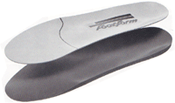Six inch dress heels for women are selling. In fact, according to today's article in The Wall Street Journal, "Women Fall Head Over Heels for Shoe Makers' Arch Designs", by Teri Agins, this super-high segment of the shoe industry is selling so well that Manolo Blanik says it accounts for about 30% of his company's business.
Despite the craziness of fashion, the most disturbing thing to me was to read was that Podiatric Surgeons are injecting cosmetic fillers such as Restylane or Juvederm to plump up the balls of the feet (metatarsal area of the foot) in an effort to ease the painful pressures on the forefoot caused by these high heels.
So here's what I have to say about these sky high shoes -- Don't wear them! Sprained ankles, artificial interventions (like injecting cosmetic fillers), and strained joints(from the gait change the shoes impose) can cause injuries that can impact your life for years.
If you want to appear tall, improve your posture. But more than that, remember that others don't see you statically, like in a photograph or the way you see yourself in front of a mirror. People perceive your age and attractiveness before they ever get close enough to see if you have a wrinkle. How you carry yourself in motion can convey confidence, athleticism, flexibility and strength.
High heels seen in motion promote the opposite of this. High heels hobble your body's motion and athleticism. You may think you look great standing still, but do you want to be hobbled and risk injury? Hobbling is defined as strapping together the legs of an animal (such as a horse)to slow it down and prevent it from straying, or to cause a person to limp. Psychologically, hobbling yourself for the sake of fashion creates a conflict between the fashion desires of your mind and the natural health of your body.
Your body has a wisdom and intelligence that knows when it's being impaired by a terrible choice of footwear. Choose to look at fashions that hobble your movement as promoting weakness rather than strength.









No comments:
Post a Comment